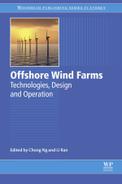Remote sensing technologies for measuring offshore wind
Abstract
Measuring wind conditions offshore can provide information that can considerably reduce the costs of offshore wind farms. It is also important to verify the power performance of the offshore wind turbines and this in particular requires accurate wind speed measurements with known uncertainties. Conventional methods for measuring the wind using mast-mounted instruments become much more costly and logistically challenging as water depths increase. Remote sensing methods are becoming increasingly able to substitute conventional measuring techniques. For wind prospecting and model validation, satellite-borne remote sensing methods are highly valuable. Synthetic aperture radars can provide relatively high resolution (ie, 1 km) and can also provide wind speeds in coastal areas. Scatterometers cover much larger areas and have correspondingly lower spatial resolution (ie, 12–25 km). Unlike synthetic aperture radars, they are able to provide both speed and direction data. Surface-based remote sensing methods offshore are mostly based on lidar technology, although some radar systems are also being introduced. Lidars measure line-of-sight wind speeds by determining the Doppler shift of coherent laser light backscattered from suspended aerosols. Wind lidars can measure accurate wind speeds up to heights relevant for wind energy. Offshore they must be placed on an existing structure (ie, mast or platform) or they can be deployed on dedicated buoys. Floating lidar systems are becoming commercially available and are able to measure mean wind speeds to a surprising accuracy. Scanning lidars placed onshore can measure the wind resource in coastal regions out to a range of about 10 km. Lidars deployed on the nacelle of wind turbines or placed on their transition piece can be used to measure reference wind speeds for power curve and load verifications.
Keywords
Lidar; Power curve verification; Resource assessment; SAR; Scatterometer; Wind speed4.1. Introduction
4.1.1. The need for data
4.1.2. The offshore reality
4.2. Conventional methods
4.2.1. Cup anemometers
4.2.2. Wind vanes
4.3. Surface-based remote sensing
4.3.1. Basic principles
4.3.1.1. The idea in a nutshell
![]() [4.1]
[4.1]
4.3.1.2. How lidars measure line-of-sight wind speeds
4.3.1.3. Continuous-wave lidars
4.3.1.4. Pulsed lidars and some contrasts to continuous-wave systems
4.3.1.5. Direct detection lidars
4.3.2. Wind lidars
4.3.2.1. ZephiR 300
4.3.2.2. Leosphere Windcube V2
4.3.2.3. The accuracy of wind lidar measurements
4.3.2.4. How wind lidars measure turbulence and gusts
4.3.2.5. Deploying wind lidars offshore
4.3.3. Floating lidars
4.3.3.1. What a floating lidar system is made of
4.3.3.2. Different ways of dealing with the motion
4.3.3.3. What floating lidars are good at and not so good at
4.3.4. Scanning lidars and radars
4.3.4.1. What single scanning lidars can be used for
4.3.4.2. Measuring using dual Doppler
4.3.5. Nacelle lidars
4.4. Space-borne RS
4.5. Case study – a near-coastal wind farm project
4.5.1. Estimating the wind resource
4.5.2. Construction phase
4.5.3. Verification measurements

4.5.4. Wake measurements
4.6. Future trends
Sources of further information
Abbreviations and Acronyms
| AEP | Annual energy production |
| CAPEX | Capital expenses |
| CDV | Committee Draft for Voting (stage of a standard) |
| CW | Continuous wave (lidar) |
| IEA | International Energy Agency |
| IEC | International Electrotechnical Commission |
| NORSEWInD | Northern Seas Wind Index Database (EU-FP7 project) |
| OPEX | Operational expenses |
| OWA | Offshore Wind Accelerator (Carbon Trust initiative) |
| RUNE | Reducing Uncertainties in Near-coastal Energy estimates (ForskEL project) |
| SAR | Synthetic aperture radar |
| UniTTe | Unified Turbine Testing (Innovation Fund Denmark project) |
